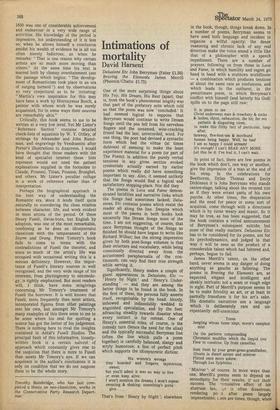Romantic artists
Timothy Bainbridge
British Romantic Art Raymond Lister (Bell £6.50) The Life and Art of Henry Fuseli Peter Homory (Thames and Hudson £7.00) Peter Tomory (Thames and Hudson £7.00) It is sometimes argued, and sometimes plausibly, that we are still too close to Romanticism in our assumptions about art to be able to define the movement properly. We still think of paintings as expressions of their creator's personality, a notion which would not have occurred very readily to anyone before the end of the eighteenth century. These. two books, one a survey of art in England from 1750 to 1850, the other a biography of the man who became Professor of Painting at the Royal Academy in 1799, in their various deficiencies effectively demonstrate the need for a fine balance of sympathy and detachment in any consideration of the period.
No great skill in logic is needed to see the weakness of Mr Lister's method, which he sets out in the opening pages of his first chapter, 'The Spirit of Romanticism.' "Certain things and certain activities are Romantic, and it is more important to understand why they are Romantic than to pin down Romanticism like a moth on an entomologist's board. Why, for instance, it is Romantic to build an aqueduct over a valley in Wales [is it?]; to revel in the sublimity of the mountains surrounding it; to make minutely exact watercolours of flowers and leaves growing there . . . " He goes on: "One central fact of Romanticism is its preoccupation with, and expression of, the individual and the particular." Here he has the makings of a point, although it is hardly a new one; it is in general true that Neo-classical doctrine preached the avoidance of the particular as vitiating the grand effect of the Ideal (this was challenged later by the amount of incontrovertibly individual detail in the Elgin Marbles). It is a point which the text occasionally returns to, but in a book of 175 pages we have a right to see it developed. Instead Mr Lister seems intent upon providing proof, as if proof were needed, of the fact that the period 1750 1850 was one of considerable achievement and endeavour in a very wide range of activities. His knowledge of the period is impressive, his understanding of it is less so; when he allows himself a conclusion amidst his wealth of evidence he is all too often merely ludicrous, as when he remarks: "That is one reason why certain artists are so much more moving than others." At the same time his text is marred both by clumsy overstatement (see the passage which begins: "The development of Romanticism took place in an era of surging turmoil ") and by observations so very conjectural as to be irritating: "Martin's own inspiration for this may have been a work by Hieronymus Bosch, a painter with whose work he was surely acquainted, for in some ways their oeuvres are remarkably akin."
Critically, this book seems to me to be written at a very low level. Yet Mr Lister's ' Reference Section' contains detailed check-lists of aquatints by W. Y. Ottley, of etchings by Alexander and John Runci man, and engravings by Vendramini after Porter's illustrations to Anacreon. I would have thought that those readers with the kind of specialist interest these lists represent would not need the patient explanations supplied in the footnotes to Claude, Piranesi, Titian, Poussin, Brueghel, and others. Mr Lister's peculiar collage is a work of reference rather than of interpretation.
Perhaps the biographical approach is the best way of understanding the Romantic era, since it lends itself quite naturally to considering the close relation between character, life, and work evident in most artists of the period. Of these Henry Fuseli, Swiss-born, but English by adoption, was one of the most remarkable, combining as he does an idiosyncratic classicism with the temperament of the Sturm und Drang. Peter Tomory's book fails to come to terms with the contradictions of Fuseli the theorist, and since so much of the artist's life was occupied with occasional writing this is a serious deficiency. However, the impor tance of Fuseli's literary sources is well recognised, and the very wide range of his interests, from physiognomy to entomolo gy, is rightly emphasised. But most readers will, I think, have some misgivings concerning Mr Tomory's treatment of Fuseli the borrower. It is well known that Fuseli, more frequently than most artists, incorporated figures from other paintings into his own, but amongst Mr Tomory's many examples of this there seem to me to be some where his zeal for spotting a source has got the better of his judgement. There is nothing here to rival the insights contained in Antal's Fuseli Studies. The principal fault of this informative, looselywritten book is a certain naiveté of approach which constantly gives rise to the suspicion that there is more to Fuseli than meets Mr Tomory's eye. If we can acquiesce in the author's conclusions it is only on condition that we do not suppose them to be the whole story.
Timothy Bainbridge, who has just completed a thesis on neo-classicism, works in the Conservative Party Research Departmer,



































 Previous page
Previous page